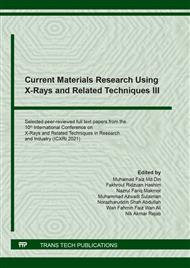[1]
Rashidi H R, Sulaiman N M N and Hashim N A, Batik Industry Synthetic Wastewater Treatment Using Nanofiltration Membrane Procedia Eng. 44 2010–2 (2012).
DOI: 10.1016/j.proeng.2012.09.025
Google Scholar
[2]
Mantzavinos D and Psillakis E, Enhancement of biodegradability of industrial wastewaters by chemical oxidation pre-treatment J. Chem. Technol. Biotechnol. 79 431–54 (2004).
DOI: 10.1002/jctb.1020
Google Scholar
[3]
Lim S L, Chu W L and Phang S M, Use of Chlorella vulgaris for bioremediation of textile wastewater Bioresour. Technol. 101 7314–22 (2010).
DOI: 10.1016/j.biortech.2010.04.092
Google Scholar
[4]
Patil A V and Jadhav J P, Evaluation of phytoremediation potential of Tagetes patula L. for the degradation of textile dye Reactive Blue 160 and assessment of the toxicity of degraded metabolites by cytogenotoxicity Chemosphere 92 225–32 (2013).
DOI: 10.1016/j.chemosphere.2013.01.089
Google Scholar
[5]
Gupta V K and Suhas, Application of low-cost adsorbents for dye removal - A review J. Environ. Manage. 90 2313–42 (2009).
DOI: 10.1016/j.jenvman.2008.11.017
Google Scholar
[6]
Kabra A N, Khandare R V, Waghmode T R and Govindwar S P, Phytoremediation of textile effluent and mixture of structurally different dyes by Glandularia pulchella (Sweet) Tronc. Chemosphere 87 265–72 (2012).
DOI: 10.1016/j.chemosphere.2011.12.052
Google Scholar
[7]
Van Der Zee F P and Villaverde S, Combined anaerobic-aerobic treatment of azo dyes - A short review of bioreactor studies Water Res. 39 1425–40 (2005).
DOI: 10.1016/j.watres.2005.03.007
Google Scholar
[8]
Mittal A, Gajbe V and Mittal J, Removal and recovery of hazardous triphenylmethane dye, Methyl Violet through adsorption over granulated waste materials J. Hazard. Mater. 150 364–75 (2008).
DOI: 10.1016/j.jhazmat.2007.04.117
Google Scholar
[9]
WHO 2012 WHO | 10 facts about water scarcity.
Google Scholar
[10]
Roongtanakiat N, Vetiver Phytoremediation for Heavy Metal Decontamination Tech. Bull. 1 1–20 (2009).
Google Scholar
[11]
Ghosh M and Singh S P, A review on phytoremediation of heavy metals and utilization of its byproducts Appl. Ecol. Environ. Res. 3 1–18 (2005).
Google Scholar
[12]
Ali H, Khan E and Sajad M A, Phytoremediation of heavy metals-Concepts and applications Chemosphere 91 869–81 (2013).
DOI: 10.1016/j.chemosphere.2013.01.075
Google Scholar
[13]
Nathan A J and Scobell A, How China sees America Foreign Aff. 91 1–195 (2012).
Google Scholar
[14]
Levinson A A, Analytical methods for atomic absorption spectrophotometry Geochim. Cosmochim. Acta 33 1315–6 (1969).
Google Scholar
[15]
Aweng E R, Anwar I, Siti Rafiqah M.I and S O, Cassia alata as a Potential Coagulant in Water Treatmen Res. J. Recent Sci. 1(2) 28–33 (2012).
Google Scholar
[16]
Rai S, Sharma D K, Arora S S, Sharma M and Chopra A K, Concentration of the heavy metals in Aloe vera L . ( Aloe barbadensis Miller ) Leaves collected from different geographical locations of India Sch. Res. Libr. 2 575–9 (2011).
Google Scholar
[17]
Subbarao G V., Ito O, Berry W L and Wheeler R M, Sodium - A Functional Plant Nutrient CRC. Crit. Rev. Plant Sci. 22 391–416 (2003).
DOI: 10.1080/713989756
Google Scholar
[18]
Wolverton B C and McDonald R C, Water Hyacinths (Eichhornis Crassipes) for Removing Chemical and Photographic Pollutants from Laboratory Wastewaters NASA Tech. Memo. 12 (1976).
Google Scholar
[19]
Muthunarayanan V, Santhiya M, Swabna V and Geetha A, Phytodegradation of textile dyes by Water Hyacinth ( Eichhornia Crassipes ) from aqueous dye solutions Int. J. Environ. Sci. 1 1702–17 (2011).
Google Scholar
[20]
Choo T P, Lee C K, Low K S and Hishamuddin O, Accumulation of chromium (VI) from aqueous solutions using water lilies (Nymphaea spontanea) Chemosphere 62 961–7 (2006).
DOI: 10.1016/j.chemosphere.2005.05.052
Google Scholar


